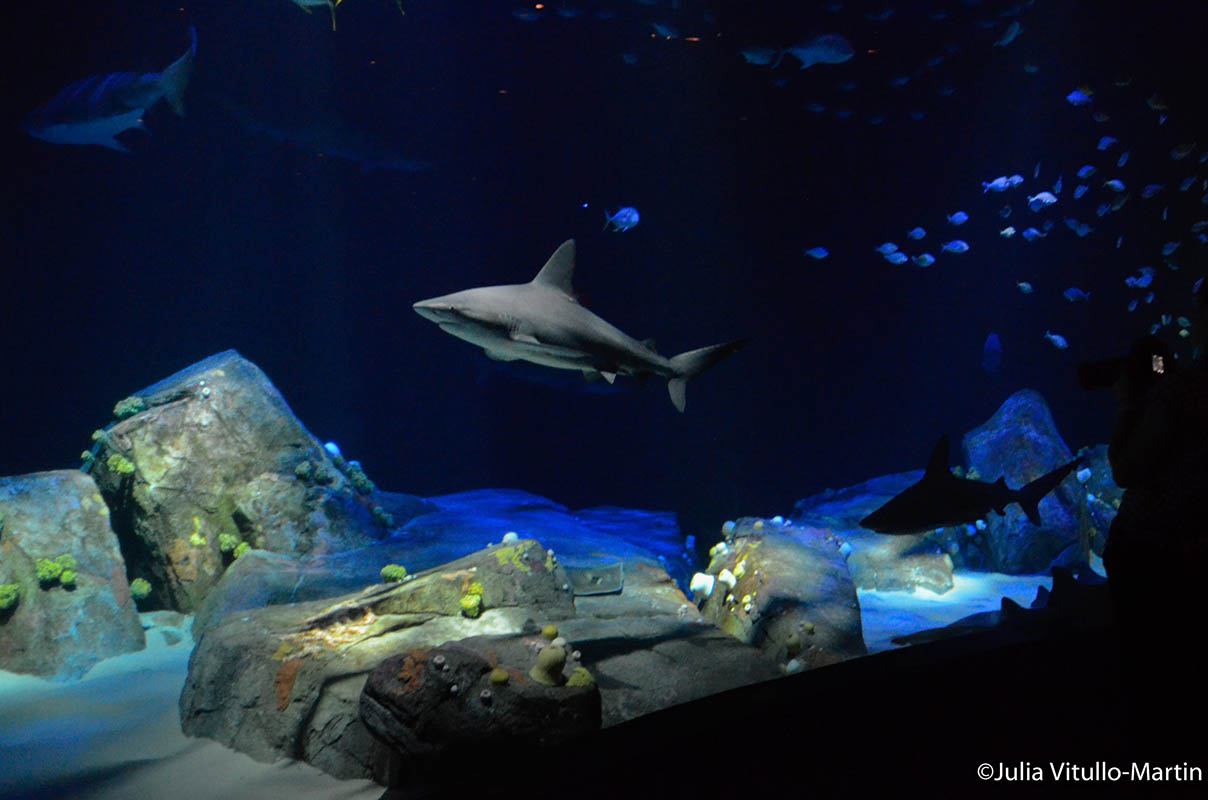Sharks! Does the Word Terrify You?
Then head for Coney Island, where the New York Aquarium’s new exhibit, Ocean Wonder: Sharks!, will replace your alarm with love and admiration. The Aquarium’s magnificent, just-opened 57,500-square-foot building holds 784,000 gallons of water, where 12 species of sharks and six species of skates and rays swim amid 115 other species of marine life. In its detailed, compelling presentations, the Aquarium doesn’t deny that many sharks are apex predators, routinely capable of wiping out a school of fish and swimming on serenely. But that’s part of the point: apex predators are crucial to the balance of nature, helping maintain coral reef habitats and ensuring the species diversity that’s crucial to a healthy ecosystem.
Are Sharks and Rays Real New Yorkers?
Yes! The waters around our island city abound with sharks and the habitats they protect. The Hudson Canyon, for example, the East Coast’s largest submarine canyon and roughly the size of the Grand Canyon, begins some 100 miles from New York Harbor and extends more than 300 miles. The Aquarium calls it, “Another New York neighborhood teeming with life.” A handsome map, New York Seascape: The Sea that Never Sleeps, that can be picked up at the Aquarium, shows New York’s abundant sea creatures living in the 16,000 square miles called the New York Bite extending from Montauk to Cape May. Of course, like many human New Yorkers, some Seascape residents avoid seasonally harsh weather by migrating long distances to more pleasant climates.
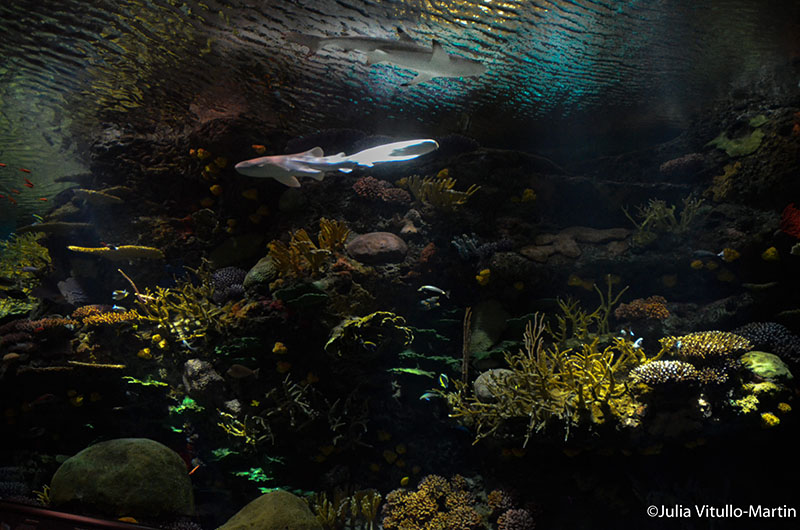
But Why No Great White Sharks in the Aquarium?
Great Whites are indeed found in New York waters, says Jon Forrest Dohlin, director of the Aquarium and vice president of the Wildlife Conservation Society, but they swim in straight lines for very long distances. The sharks chosen for the exhibit—sandbars, sand tigers, nurse sharks, for example—swim more slowly and move in and out of tight spaces. Wild Animal Keeper Timothy Vourderis is especially fond of sandbar sharks, which grow to six to eight feet in length. Quick and agile, they have a large first dorsal fin and pectoral fins that reach over a foot long, letting them navigate effortlessly through water with a flick of the tail. “Their upper teeth that continually replace,” says Vourderis, “are triangular and broad with many serrations designed for cutting. Their lower teeth are smaller and pointed, making it difficult for their evading prey to be successful.”
So Why Don’t the Sharks Eat All Their Little Neighbors?
We feed them extremely well, says Dohlin delicately. Fed 180 pounds of herring, squid, and capelin weekly, the sharks have little incentive to search for their own food among the schools of lovely small fish swimming among them. Plus, quite a few of the small fish are bony, and therefore not that tasty to sharks. Still, in a post for WCS Vourderis notes that his favorite sandbar shark, Malcolm, likes to swim through “very cautious jacks.”
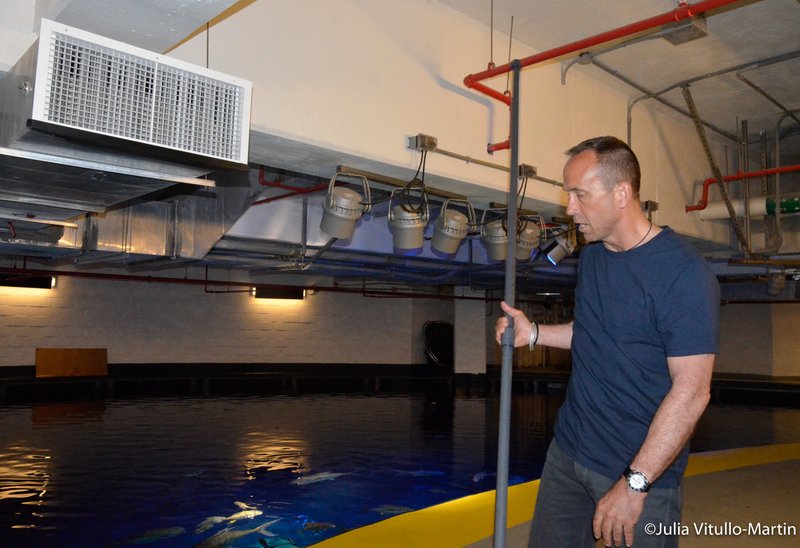 NYA Director Jon Dohlin holding a feeding target at the top of the Canyon’s Edge tank.
NYA Director Jon Dohlin holding a feeding target at the top of the Canyon’s Edge tank.
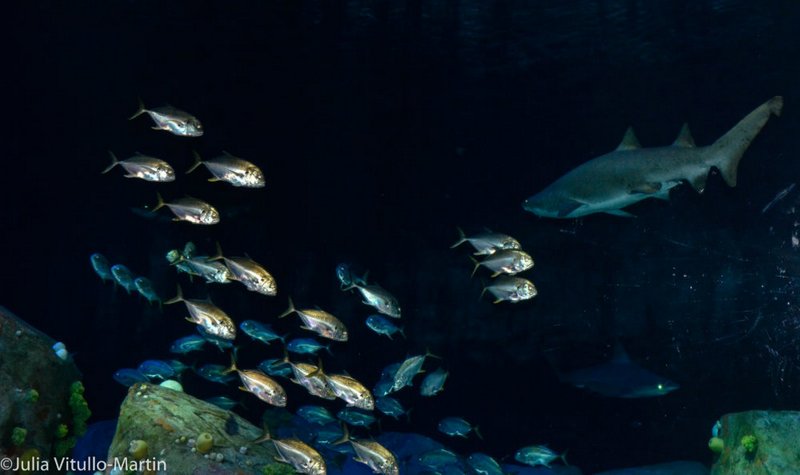 Hundreds of bony fish, including striped bass and crevasse jacks, swim with the sharks and try to avoid being eaten.
Hundreds of bony fish, including striped bass and crevasse jacks, swim with the sharks and try to avoid being eaten.
Will Children Be Able to Understand Ocean Wonder?
The highly interactive exhibits allow visitors to read, ponder, and participate, asking and answering the questions we all have, especially children. What makes a shark a shark? Dramatically pictured answers: cartilage skeleton: flexible and light, and denticles: tooth-like scales. What do sharks really eat? Different shark heads are shown with open mouths (you can insert your hand) and an array of teeth evolved to work well for what various species like to eat, from plankton to fellow fish. As feeders sharks have the immense advantage of a “sixth sense,” by which receptors on their heads detect faint electric signals produced by the muscle contractions of other animals.
One of the most popular exhibits is the touch tank, where small sharks can be carefully touched by visitors who receive gentle but precise instructions from the attentive ranger.
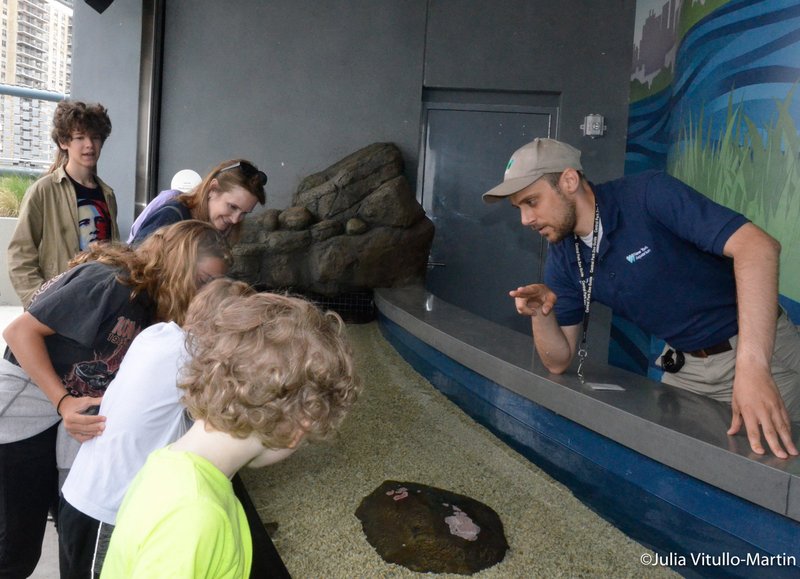 After carefully washing hands visitors can touch small sharks, such as epaulettes and white spotted bamboos.
After carefully washing hands visitors can touch small sharks, such as epaulettes and white spotted bamboos.
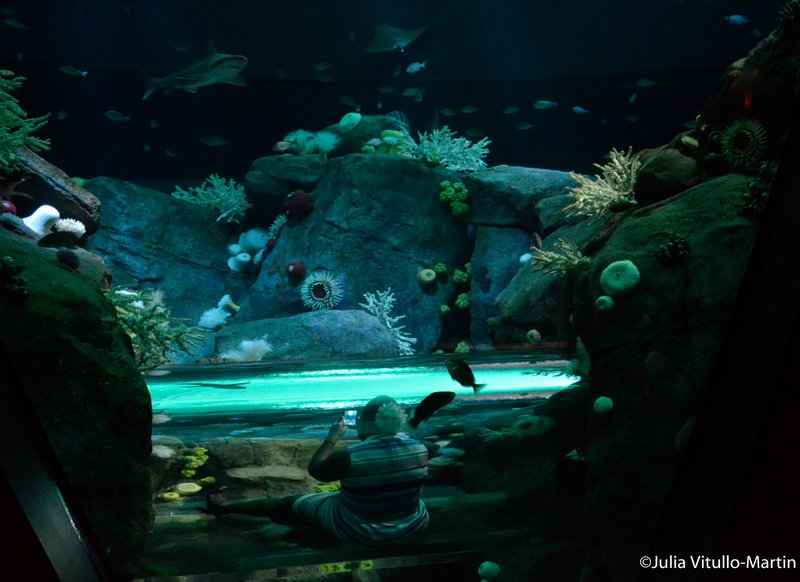 Visitors can walk or sit in the immersive, underwater Coral Reef tunnel, which allows them to view sharks swimming overhead.
Visitors can walk or sit in the immersive, underwater Coral Reef tunnel, which allows them to view sharks swimming overhead.
Sharks: They’re Just Like Us
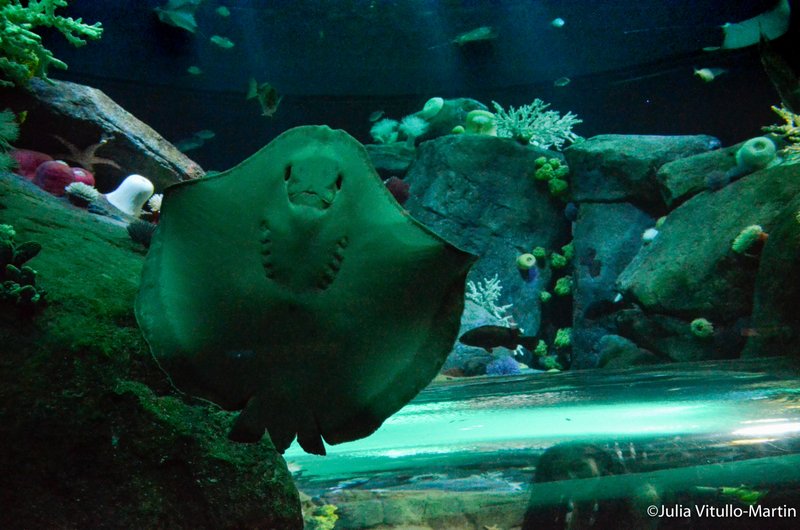 Stingrays may be the happiest looking of the Aquarium’s cartilaginous fish
Stingrays may be the happiest looking of the Aquarium’s cartilaginous fish
It is remarkably easy to anthropomorphize sharks while watching them in the Aquarium for long periods, as their individuality and beauty come to life. But scientists say there is some truth to this, that individual sharks have personalities, says a WCS post. Scientists from Australia’s Macquarie University documented personality traits among Australian sharks, concluding that each individual had a distinct level of “boldness” that remained consistent across repeated trials. “Sharks are not just mindless machines,” said study director Culum Brown.
What Happens When the Next Hurricane Hits?
New York is a coastal city and Coney Island sits on the shore of the unruly Atlantic. Hurricanes will return and wreak their damage, but the Aquarium has learned a great deal from its 2012 experience with Superstorm Sandy. “I thought we had lost the Aquarium,” says Dohlin, standing front of the immense new sand filters, just one element in the advanced filtration systems that are part of the building. “It looked demolished.” Sandy’s timing was particularly disheartening, says Dohlin, because “we were about to begin the biggest capital expansion project in our history, the shark exhibit.”
As the New York Times wrote in 2012, Sandy “immediately knocked out the aquarium’s electrical transformers and damaged its electrical distribution system and mechanical equipment, rendering emergency generators useless. And it ruined the pumps and motors that operate critical life support systems for the fish like oxygenation, filtration and heat.” Aquarium employees worked round the clock pumping water from the basements and getting generators running.
 Jon Dohlin explaining the Aquarium’s new hurricane-combatting technology, standing in front of sand filtration tanks
Jon Dohlin explaining the Aquarium’s new hurricane-combatting technology, standing in front of sand filtration tanks
Then the task became building a structure that would minimize the effects of future storms. Dohlin concluded that one lesson from Sandy was that the Atlantic Ocean is going to go where it wants to go, and the Aquarium’s job was figuring out how to install the most advanced systems to handle future storms. Donald Zucker, the developer whose name graces Sharks!, said at the ribbon cutting that this was the most complex New York City building he had ever seen in a lifetime of building. Every element was thought through in its relationship to the ocean. “We can’t prevent hurricanes,” says Hope Cohen, COO of the Battery Conservancy, which faces similar issues overseeing its park on the shore of Lower Manhattan. “We can only prepare for them. Resiliency, the ability to bounce back from disaster, is essential to New York’s character. With much of its 520 miles of coastline borrowed from the sea, New York will find that the sea will sometimes reclaim its property. Coastal neighborhoods must design and build to accept water blows and rebound, which is precisely what the Aquarium’s new construction is doing.”
We Kill Far More of Them than They Kill of Us
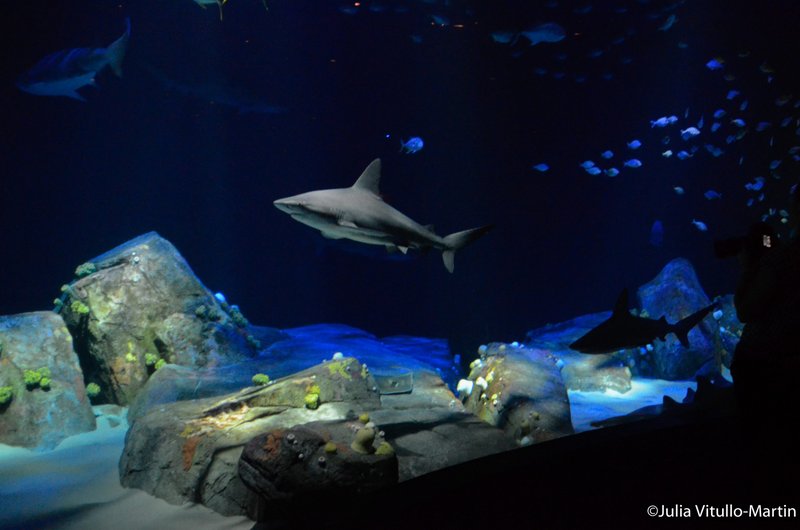 Millions of sharks, especially sandbars, are killed annually for shark fin soup. Their fins are cut off and their bodies thrown back into the ocean.
Millions of sharks, especially sandbars, are killed annually for shark fin soup. Their fins are cut off and their bodies thrown back into the ocean.
Jaws, the 1975 Steven Spielberg film about a great white shark terrorizing a coastal town which is being shown on local television this month, did immense ecological damage to sharks by encouraging and justifying overfishing. Yet as New York Times critic Vincent wrote at the time, “If you think about Jaws for more than 45 seconds you will recognize it as nonsense.”
Still, says Wendy Benchley, widow of author Peter Benchley who wrote the original book, says Jaws inadvertently tapped into people’s deepest fears. Benchley himself quickly came to regret the ensuing slaughter, financing a strong shark conservation movement with his profits from Jaws and working to save sharks until his death in 2006. In his interview for WildAid he discusses the infinitesimally small number of human beings killed by sharks, in part because we don’t taste very good. We have too many bones, so sharks often take test bites, and then reject human prey, which is why most shark attacks are not fatal. The chance of being killed by a shark is one in 3.7 million
Contrast the handful of human fatalities from sharks with the 100 million sharks who are killed annually by human beings, most to feed the huge global market for shark fin soup. “Fishermen seize the animals by harpoon or large calipers and haul them on deck,” writes Narratively, “where they mercilessly slash side and dorsal fins in a pool of crimson. The animal shows its agony in its contortions, jerking and struggling with each slash of the knife.”
Sharks have been on the earth for 450 million years. The Aquarium and the WCS are doing their best to ensure that this long run continues well into the future. They hope all New Yorkers will join them.
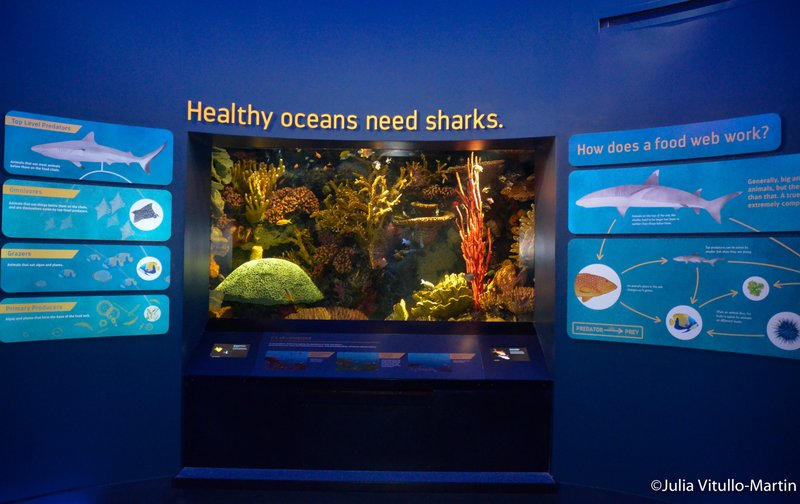
The New York Aquarium, located at Surf Avenue and West 8th Street in Coney Island, is reachable by MTA subway (F or Q to West 8th Street or N or D to Coney Island-Stillwell Station, walking two blocks east on Surf Avenue), MTA bus (B36 to Surf Avenue and West 8th or B68 to Neptune Avenue & West 8th, then walking south on 8th Street), or car (navigate your GPS to 602 Surf Ave. Brooklyn, NY 11224).
Open year-round, hours are typically 10 AM-6 PM Monday through Thursday and 10 AM-7 PM Friday through Sunday. The last entry is one hour before closing.
In appreciation of New York City’s support for the aquarium, half-price admission tickets are offered through Sept. 3, 2018: adult admission, $14.95 (reduced from $29.95); senior, $11.95 (reduced from $26.95); child 3-12, $11.95 (reduced from $24.95). Children 2 and under are free.
Julia Vitullo-Martin is a Senior Fellow at Regional Plan Association. Get in touch with her @JuliaManhattan.






